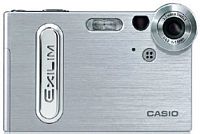Regular readers will know that the Ferret has reported favourably in the past on the Exilim range of digital cameras from veteran Japanese company Casio. Well the newest addition to the family – the EX-S3 – has finally reached my hands and so here is a quick overview of the product after a few days use.
First Impressions
First off, Casio has managed to retain the same fab shape and size form factor of the original S models. I must admit that when they recently announced the Z3 my heart sank, as I thought that the company had decided to move away from the slim credit card size of the original in order to add more features. My fears, however, were unfounded, as the new EX-S3 is just about identical in feel as the original. Yeah!
Interestingly enough, the user manual for the camera now explicitly suggests that you use the wrist strap to avoid dropping the tiny device, which of course shows just how closely the Casio folks read the Ferret (our original comment was ‘I very quickly realised that in order to use it properly I needed to attach the wrist strap, to avoid it slipping out of my hands….’
Another nice feature which has been added is the automatic lens cover It doesn’t slow down the start up time at all but does provide more security to this pocket friendly design. Nice one folks! (our original comment on the EX-S2: ‘I am a little surprised that Casio didn’t include a lens cover…’)
In Use
Well to be brutally honest, there’s not much to add to the use aspect of the EX-S3 that we didn’t say before about its predecessor. It’s still a joy to carry around, slung onto the wrist strap and ready for instant action. It still starts up in the blink of an eye, and shoots well adjusted photos, but there are a couple of important things to mention.
Small camera size = candid photos!
Firstly, the 3.2 megapixel CCD spec does make a difference. I really liked the EX-S2 but did feel that the picture quality was not quite up to snuff. It was not bad, just somewhat inconsistent in certain lighting conditions. The new model, however, really does produce photos which I think are an improvement in just about every situation. Obviously I haven’t played with it for very long as yet, but the shots you see here are fairly representative of the kind of thing that it will produce.
Again as with the last review, I am not shooting on max size because I don’t really need massive printouts. Although the max image size is now 2048×1536 I have the camera set at 1280×960 on Fine, which gives perfectly adequate results for a happy snapper like me, and also gives 41 shots on a 32 MB SD card. Anyone buying the camera, however, should probably invest in a 64 MB card as a minimum.
Full size 2048×1536 photo (1.6MB)
Battery life again looks to be on a par with the S2, giving around a day’s worth of outdoor shooting (maybe 50 shots or so at the end of my ‘in the field’ editing).And remember that this model sports the new larger 2″ LCD, which says a lot about the product’s excellent power management.
You can now also record audio in the video capture mode (via a tiny mic on the front), which means that you can get really neat little 1/2 VGA sized videos (max 30 seconds per clip) to email and post to the Web at the drop of a hat. Yet more cool versatility out of such a teeny gizmo, although be aware that video does eat up battery life.
Moody Night Shot scene is still fab!
Finally, I have to mention the upgraded Best Shots. There are now 15 built in ‘scenes’ which you can use, including the original model’s excellent Night Scene, Retro and Twilight. The new additions include a really interesting scene which you can use when there are only two of you and you want a piccie with both of you in the photo. It’s called Coupling Shot and you use it by taking a shot with one of you in the frame, changing places, lining up the scene again and taking the shot with the other person standing ‘next’ to the original.
I haven’t explained it very well, and it’s a tad more fiddly to use than Casio makes it sound, but it’s still a great feature to have if there’s nobody else around to capture that special shot of the two of you at the top of Everest! You can also create and store your own scenes, so if you find a setting that suits your kind of photography you can store it for repeated use later on.
So?
This is really a nice camera. It’s ultra portable, takes great shots at the drop of a hat, lets you try out some cool tricks if you feel adventurous and has great battery life. In the last review I complained about the power button being too close to the shutter button and they’ve now recessed – and moved? – it a little, so that it’s not so easy to confuse the two. I also complained about the awkward jog stick used for navigation and it’s now gone, replaced by a really good and tactile switch and button assembly. Navigation is now a snap.
The camera still, however, lacks a printed ‘get started’ guide (the manual is still on CD – shame, shame) and more importantly a macro mode. Even with a lowering of the minimum focus distance down to 80cm, this is still a bit of a pain, as some great shots come out of macro mode. It also means that things like product close-ups are still a problem for professional tech journos like me. Especially small products like cellphones. Cant’ someone come up with an add-on lens which converts the camera to macro?
The other negative is that you need to install and hook up the cradle in order to download photos to your PC and charge the camera, as there is no USB or power port on the camera body, only a cradle port. You can overcome this by downloading images from the SD card using a card reader, and you can buy a separate �45.00 battery charger to juice up the batteries on the go, but these are still limitations on an otherwise excellent product.
The biggest problem is that it makes holiday use a bit more of a chore if you have to lug around the cradle. I think that the company should really consider introducing a simple travel power cable which can fit into the cradle socket on the camera to recharge the Lithium Ion NP20 battery.
I’ve been reviewing digital cameras professionally – i.e. in more detail :-) – now for around seven years since I first carted a Casio QV-10 on a cross America hike. That little doozy had a 250K (yes K) pixel CCD and cost around $650.00, so we’ve come a long way baby. This new Exilim EX-S3 camera is the first I’ve handled in all that time which I can see myself living with for a long time. Sure resolution may improve, and the moment a macro version hits the streets I’m there, but still and all this is a great product for my happy snapping needs.
If you’re looking for top notch photo results, then maybe you need to look elsewhere, because you’ll need the lens attachment and shooting flexibility that this camera cannot deliver. But if it’s portability you need, then this is the Neo of digicams at the moment.
Priced at around �299.00 ($350.00) from major retailers.








